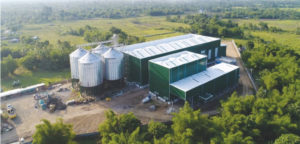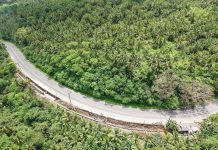Renucci couple initiated the modern rice processing center

ALANGALANG, Leyte- Five years since super typhoon “Yolanda” caused destruction in Leyte, the husband-and-wife team of Patrick Renucci and Rachel Renucci-Tan are finally seeing their dream of a “rice revolution” turn slowly but surely into reality.
Last October, the Renuccis successfully tested and commissioned the silos, wet bins and driers that form part of the state-of-the-art Renucci Rice Processing Center, considered the most technologically advanced center of its kind in the Philippines.
The Renuccis believed that the Philippines can become more than self-sufficient when it comes to rice, the most widely consumed staple in the Philippines, if farmers are given adequate access to high quality inputs such as seeds, fertilizers and basic mechanization.
Renucci-Tan said that the perennial problem of low productivity hounding the country’s rice farmers had little to do with having small parcels of noncontiguous land or inadequate irrigation.
The root of the problem, she said, was the farmers’ lack of easy access to capital to produce adequate farming inputs, including high quality seeds and fertilizers, as well as basic mechanization for them to make the most of their land.
“Their debt trap is also a major culprit as they sell whatever farming inputs they can amass just to be able to pay back their debt to usurious traders who also provide the farming inputs,” she said.
The Renuccis have proven over the past four years of working closely with the farmers that given the right inputs that the farmers can pay through low-interest loans, plus access to basic mechanization to speed up planting and harvesting, farmers can produce at least seven metric tons of rice per hectare, which is comparable to the output in Thailand and Vietnam, two of the world’s leading rice exporters.
The full operation of the Renucci Rice Processing Center aims to further increase productivity since the palay will be processed properly and efficiently to maximize rice output.
“For the first time, wet palay is pre-cleaned before drying—removing dirt, stones, grass, pests and other impurities. Clean palay is then electronically weighed as part of the drying system to ensure scientifically precise moisture extraction. Simply drying the palay under the sun keeps moisture and pests trapped in the grains. Dried palay is then stored in chilled, fully aerated and temperature controlled wet bins and silos,” she said.
The entire process from palay intake to drying to storage in silos is managed from a single control room, she said. There are virtually no production errors. Production is optimized and costs are reduced, thus boosting the income of farmers.
The fully automated, digitally controlled driers bring down the moisture content of palay to the desired 14 percent Renucci-Tan added.
(LIZBETH ANN A.ABELLA)



